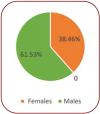Blood Culture Contamination Rate as a Quality Indicator - a Prospective Observational Study
- PMID: 36032604
- PMCID: PMC9375895
- DOI: 10.26574/maedica.2022.17.2.311
Blood Culture Contamination Rate as a Quality Indicator - a Prospective Observational Study
Abstract
Introduction: Blood culture test is the gold standard test to diagnose bloodstream infections, but contamination is the main problem in this valuable test. False positive results in blood cultures are mainly due to contamination that occurs mostly during pre-analytical procedures like sample collection and sometimes during sample processing. Materials and method:Our prospective observational study was undertaken at St. Theresa Hospital, Hyderabad, India, during January 2020-June 2020. Blood cultures received from inpatient departments (IPD) and outpatient departments (OPD) are included. Sample size: The contamination rate was calculated by dividing the total number of contaminated blood cultures by the total number of cultures multiplied by 100. Results:Blood culture contamination rate is 2.4%, which is within the limit as per the standard guideline. Conclusion:Contamination occurred mainly due to improper disinfection of the skin and environmental contamination.
Figures






References
-
- Dargère S, Cormier H, Verdon R. Contaminants in blood cultures: importance, implications, interpretation and prevention. Clin Microbiol Infect Dis. 2018;24:964–969. - PubMed
-
- Chandrasekar PH, Brown WJ. Clinical issues of blood cultures. Arch Intern Med. 1994;154:841–849. - PubMed
-
- Mylotte JM, Tayara A. Blood cultures: clinical aspects and controversies. Eur J ClinMicrobiol Infect Dis. 2000;19:157–163. - PubMed
-
- Wilson ML, Clinical and Laboratory Standards Institute. Principles and procedures for blood cultures: approved guideline. Wayne, Pa.: Clinical and Laboratory Standards Institute; 2007.
Publication types
LinkOut - more resources
Full Text Sources
